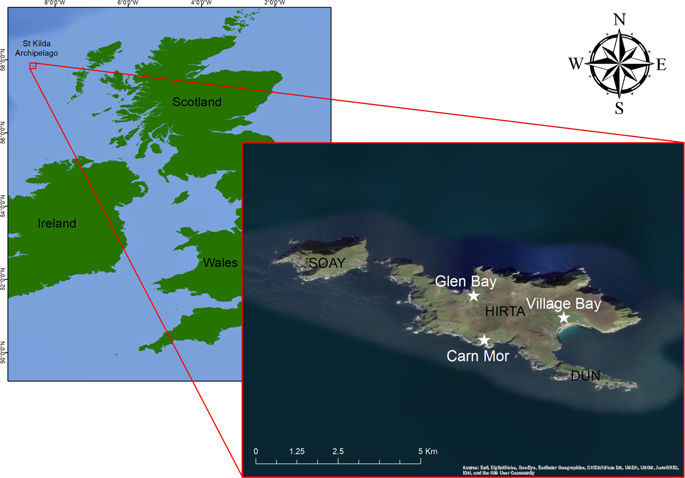Scientific Reports ( IF 3.8 ) Pub Date : 2020-04-08 , DOI: 10.1038/s41598-020-62672-x Anthony W J Bicknell 1, 2 , Benjamin W Walker 1 , Tom Black 3 , Jason Newton 4 , Josephine M Pemberton 3 , Richard Luxmoore 5 , Richard Inger 1 , Stephen C Votier 1

|
Introduced mammals have devastated island nesting seabird populations worldwide. Declines in breeding seabirds on St Kilda, UK, have been linked to climate change and predation from great skuas Stercorarius skuas, but the introduced St Kilda field mouse Apodemus sylvaticus hirtensis may also play a role by feeding on adults, chicks or eggs. Here, we use stable isotopes in St Kilda mouse blood and potential dietary items to investigate their foraging ecology, specifically focussing on the importance of seabirds and marine foods in their diet. Mice were seasonally sampled at three sites on Hirta, St Kilda over three consecutive years (2010–2012). The δ13C and δ15N ratios were used in analyses, including isotope niche and dietary source mixing models, to examine foraging behaviour among locations and between seabird breeding seasons. Mice sampled in Carn Mor – where the majority of the island’s seabirds nest - had consistently higher δ13C than other locations throughout the year, with δ15N also being significantly higher for all but one comparison. The isotopic niche width (SEAs) of Carn Mor mice in each season were distinct from the other locations, and became smaller during the seabird breeding season. Dietary mixing models revealed that seabirds made up a large proportion of the diet for mice from Carn Mor, particularly during the seabird breeding season. In conclusion, our work reveals that seabird-derived foods are likely to form a significant part of the diet of St Kilda mice populations located in and around breeding colonies. It is unclear however, whether this is from scavenging or predation of seabirds, or through their discarded food items. Given that mice have had significant effects on seabird populations elsewhere, it is important to carry out further work to determine whether mice are a significant cause of seabird mortality in this island ecosystem.
中文翻译:

稳定的同位素揭示了海鸟和海洋食物在圣基尔达田鼠的饮食中的重要性。
引进的哺乳动物破坏了全球范围内的岛屿筑巢海鸟种群。英国圣基尔达(St Kilda)上海鸟繁殖的下降与气候变化和大斑ku(Skuas Stercorarius skuas)的捕食有关,但引进的圣基尔达(St Kilda)田鼠Apodemus sylvaticus hirtensis也可能通过成年,雏鸡或卵为食。在这里,我们使用St Kilda小鼠血液中的稳定同位素和潜在的饮食项目来调查它们的觅食生态,特别着重于海鸟和海洋食物在饮食中的重要性。连续三年(2010-2012年)在圣基尔达(Hirta)的三个地点对小鼠进行季节性采样。的δ 13 C和δ 15在分析中使用N比值,包括同位素生态位和饮食来源混合模型,以检查地点之间和海鸟繁殖季节之间的觅食行为。小鼠在卡恩铁道部采样-其中大部分岛上的海鸟筑巢的-始终高于有δ 13比全年其他位置C,具有δ 15除了一个比较之外,其他所有元素的N值也明显更高。每个季节的Carn Mor小鼠的同位素生态位宽度(SEA)与其他位置都不同,并且在海鸟繁殖季节变得更小。膳食混合模型显示,海鸟占了Carn Mor小鼠饮食的很大一部分,尤其是在海鸟繁殖季节。总之,我们的工作表明,源自海鸟的食物很可能构成位于繁殖群体及其周围的圣基尔达小鼠种群饮食的重要组成部分。但是,尚不清楚这是来自清除或捕食海鸟,还是来自其丢弃的食品。鉴于老鼠对其他地方的海鸟种群有重大影响,











































 京公网安备 11010802027423号
京公网安备 11010802027423号